A country’s History can easily be found in its heritage - whether intangible or tangible. The first includes folk songs and oral traditions, cooking practices, superstitions, or ways of living; while the latter includes built heritage, like important constructions, churches, roads, etc. but also smaller details, like handmade pottery, weaved carpets, or wicker items. These are traditions that come from long ago, some of them with origins lost in time but still alive in today’s modern world. Portugal is a real haven of these. The country has a variety of material heritage, concentrated in small production hubs that still use centuries and even millennia-old techniques and materials. Even if it is becoming harder and harder to say nowadays where those traditions originated from, the fact is that keeping them is for the Portuguese a matter of national pride and honor. You will find them in small towns, villages or hamlets, or eventually at traditional stores in bigger cities. If you take a minute to learn more about them, you are sure to enter a magical world of folk tales and legends. Come along with us on this journey to discover some of the best material heritage of Portugal.
Arraiolos Carpets
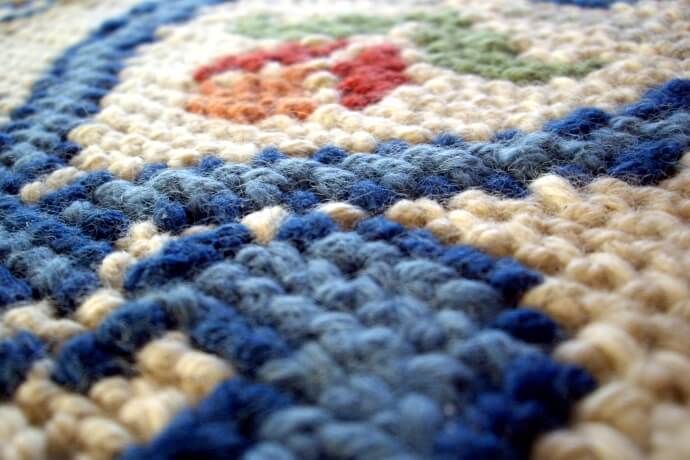
Arraiolos is a small town in Portugal in the southern region of Alentejo. Its location is reason enough to visit as Alentejo has wonderful landscapes and several UNESCO World Heritage Sites. However, Arraiolos has something more to offer: the famous Tapete de Arraiolos, or Arraiolos Carpets, a tradition of the city, and unique in Portugal.
Made from cotton canvas and woven with pure dyed wool, Arraiolos carpets are tapestries whose specific technique makes use of cross-stitch. The stitch is called Ponto de Arraiolo, hence the name of the style of the rugs. The tradition is passed from generation to generation and brings each era's cultural characteristics reflected in the tapestry's designs. Handmade by embroiderers, the Arraiolos carpets are considered part of the country's heritage.
The origin of Arraiolos carpets is uncertain, but studies indicate that the tradition began around the 16th century, when Muslim carpet makers were expelled from Lisbon by King Manuel. They would have settled in Arraiolos and continued to exercise their professions, prospering in the city and passing the technique on. The tradition ended up gaining strength in the hands of the embroiderers, who passed the technique from mother to daughter and until today work weaving by hand. The productions are made both in small factories and at home by the local families. It is possible to buy ready-made rugs or place orders. The vendors also usually offer repair, restoration, and cleaning services for the carpets, which need to be handled with great care, since they represent centuries of tradition!
The carpet-making is so important in the town of Arraiolos that there is even an annual cultural event celebrating this tradition. It is called O Tapete Está na Rua (The Carpet is Out in the Street) and takes place in May. Arraiolos also has the Arraiolos Carpet Interpretive Center and a Monument to the Carpet Maker.
Although the technique has been passed down from generation to generation, unfortunately nowadays there are few women who still work with embroidery. The younger generations are not dedicating themselves to the profession and, for this reason, it is more common to find older ladies at work than young people. Pay attention to the details of the stitches, which must show some irregularity, because of the handicraft. Since they are handmade, the cost of a rug from Arraiolos is elevated. However, think that it is a local handicraft, of ancient tradition, and usually made by old ladies who spend their days embroidering! To buy a real Arraiolos carpet goes far beyond buying a beautiful decoration item. To do it is to encourage a centuries-old tradition of intricate work and cultural knowledge, besides truly representing a little piece of Portugal. yourself!
Burel Capes from Serra da Estrela
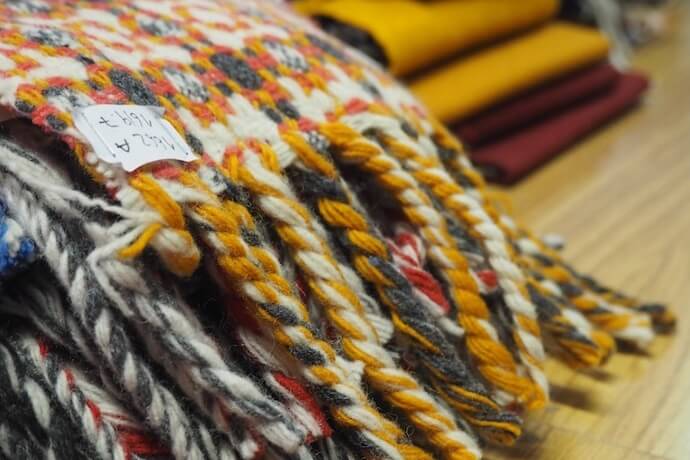
We have to go up to the highlands to tell the story of this rustic and rough fabric, the Burel, made from the purest wool from Bordaleira and Churra Mondegueira sheep. After being carded and crushed, the wool is spun and twisted (with a spinning wheel and spindle) ideally by the same person so that the yarn keeps a regular thickness and texture. After being twisted, the wool is warped and then put into the pisão, a machine that beats and scales the wool in order to make the cloth tougher and tighter. The floored webs are then delivered to a tailor who turns them into burel coats, jackets, vests, and pants for the countless rain, snow, and windy days on the hill. Today, the item most in use is the burel cape ou Manta de Burel.
In the olden days, the traditional burel cape clothed and warmed shepherds in the Serra da Estrela, the highest point in continental Portugal and also one of the coldest regions in the country. Being so warm and malleable, the fabric has had many uses throughout time and was even used as a royal mourning garment in the Middle Ages and was almost on the verge of extinction. It was already in this century that it gained new life, new uses, and new markets. In the restored 19th-century wool factory in the village of Manteigas, near Serra da Estrela, old machines are still weaving the threads of this 100% Portuguese product. You can buy them on-site or online, but either way you will know that when you buy a burel cape you will have bought an item for life!
Black Pottery of Bisalhães
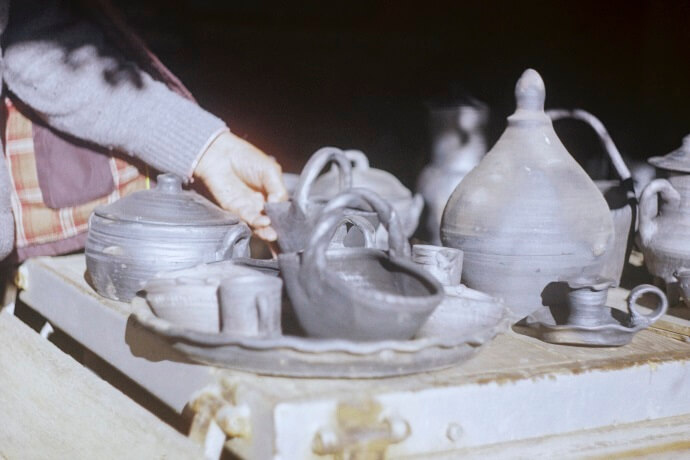
Bisalhães is a small town in the North of Portugal belonging to the district of Vila Real, the capital of the Douro region. If during your wanderings between say Porto and the Douro Valley you find yourself in the vicinities of Vila Real, go and take a look at the beautiful and quaint Bisalhães. This ancient town seems to have come to a halt in the passing of time and stepping into it is like taking a step into a time of simpler ways of living and of traditions deeply connected with the land around. Here, a very characteristic type of pottery is made using techniques and materials from centuries ago providing for a very special pottery production with unique-looking items – the Black Pottery or Olaria Negra.
The pottery-making process of Bisalhães dates to at least the 16th century. This ancestral process involves baking the pieces made by potters in open ovens in the soil, where broom, pine needles, and carquejas (a type of gorse), are burned and then smothered with earth that, mixed with smoke, gives the clay pieces their black or dark anthracite color. The secret to achieving it is in the oven and the baking methods. There are seven ovens in the village and they consist of a hole in the ground, with clay-covered walls. The pieces are placed on an iron grid, with the wood crackling. For the items to bake completely, a layer of burning green pine branch is put on top of the items that are to bake. To prevent the release of smoke when in they are in, the oven must be "smothered" with layers of pine needle, moss, and earth. And it is in this that lies the secret of the color of Bisalhães pottery. Smothering the baking causes the black color to show through in the final product. If not smothered, the color of the earthenware would be reddish as it is commonly seen in other places. To achieve perfect baking, about twenty-four hours are required.
The pieces, whose shapes are passed on through generations, tell a little of the history and habits of the county's inhabitants. In the village of Bisalhães, the most popular items are the churras, which are dishes for the oven; the roasting pan; the bowl for rice, and the pots. There are also less practical, yet more decorative items like jars, ring vases, pichorras for drinking wine, and so many others that delight visitors and will certainly delight you if you happen to pay a visit to the town.
This incredible manufacturing process of the Black Pottery of Bisalhães was declared an Intangible Cultural Heritage of UNESCO in 2016.
Estremoz Clay Figures
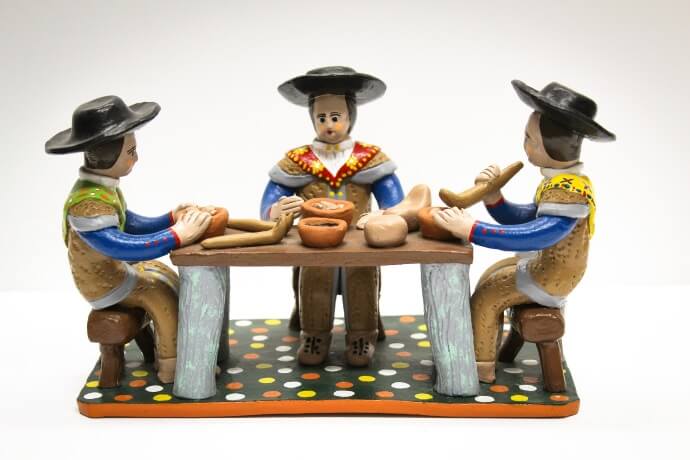
Estremoz is a city of whitewashed houses, with cork fields and olive groves as a backdrop in the equally beautiful region of Alentejo. A place where the hours seem to go slower and life has a calmer pace, due to the hot summer days and the patience and tenacity of its inhabitants.
These are fundamental traits of character to preserve the tradition of Bonecos de Estremoz or Estremoz Clay Figures making, an art that is more than three centuries old and is part of the cultural identity of the region.
Hundreds of different figures have been invented and new themes are created every day, always related to the daily life of the people of Alentejo, both in rural and urban areas. The skillful hands that work the clay give life to the emblematic dolls that, with their bright colors and unique shapes, enchant those who are fortunate enough to pass by here. The most famous are the Nativity scenes, the "Love is Blind" figure, the "Spring", the "Noblemen and Nobles" or the "Queen Saint Isabel" doll. Since 2017, Estremoz's production of clay figures has been included in UNESCO's list of Intangible Cultural Heritage of Humanity.
The first references to Estremoz figures date back to the beginning of the 18th century. In 1770, there are records of the existence of "boniqueiras", women who would make curious clay figures and whose work was yet to be recognized as a craft. The dolls certainly started out of spiritual necessity. In a time when people wanted to have the statuettes of saints of their devotion at home but buying them was impossible given the difficulties of daily life, some dared to try their own clay modeling, in a land where clay was abundant and so the tradition was born!
Estremoz is a land of authenticity and the figurines reflect precisely that. We suggest that you take a slow walk through the city, where you can appreciate and buy the best pieces from local clay artists in various stores and workshops. These are mostly dolls and local life scenes that are as naïf as they are genuine. True one-of-a-kind art pieces that represent centuries of knowledge and self-learned artistry that will certainly out stand when you display them at home.
Cowbells from Alentejo
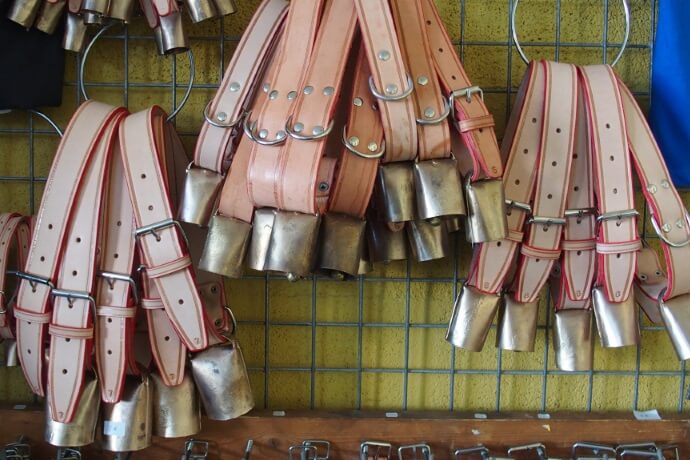
If one had to describe the sound of the Alentejo, one would probably say the sound of cicadas and cowbells in the distance. Profoundly rural and with vast plains stretching to as far as the eye can see, the region has a long-lasting tradition of cowbells-making which has been awarded in 2015, the classification of Intangible Cultural Heritage by UNESCO.
It is in the town of Alcáçovas that most of the manufacture of Portuguese cowbells takes place and where the Museu do Chocalho (Cowbell Museum) can also be visited. The exhibition consists of a private collection of over 3,000 items gathered over 60 years. Cowbells-making is a centuries-old metallurgical activity deeply associated with pastoralism and consists in the production of a so-called "idiophone" in wrought iron that is suspended around the animals' necks on a collar. The craft is passed down through generations of craftsmen, usually belonging to the same family, and requires a very specific manual process before the pieces are polished and given the finishing touches.
The Portuguese cowbell is a recognized traditional percussion instrument that provides an unmistakable sound, that plays an important part in the soundscape of rural areas where animals like sheep, goats, and oxen are still herded. A soft, characteristic sound that will also be a way to travel back to your happy days in the Alentejo, even if just for a moment while the bells toll.
A country of cherished traditions
Portugal has always had one foot in the Past while the other one is jumping fast into modernity. The country which is now one of the most technologically advanced in Europe is also one of great respect for its traditions and the Portuguese are proud people who will only be happy to show them to any visitor. Holding and buying any of these objects or many others that are part of the Portuguese material heritage is a unique way to get to know the country and its people. It is the best way to start untangling the thread of History and to have the full certainty that what you are holding and taking with you is a piece representing millennia of stories, hard work, and mostly culture. And all of this can be done while having the time of your life through your tour of Portugal.



